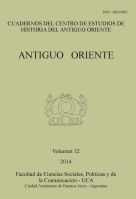Por favor, use este identificador para citar o enlazar este ítem:
https://repositorio.uca.edu.ar/handle/123456789/6789| Campo DC | Valor | Lengua/Idioma |
|---|---|---|
| dc.contributor.author | Singer-Avitz, Lily | es |
| dc.date.accessioned | 2019-06-19T23:33:13Z | - |
| dc.date.available | 2019-06-19T23:33:13Z | - |
| dc.date.issued | 2014 | - |
| dc.identifier.citation | Singer-Avitz, L. The date of the Qurayyah painted ware in the southern Levant [en línea]. Antiguo Oriente.Cuadernos del Centro de Estudios de Historia del Antiguo Oriente. 2014, 12. Disponible en: https://repositorio.uca.edu.ar/handle/123456789/6789 | es |
| dc.identifier.issn | 1667-9202 | - |
| dc.identifier.uri | https://repositorio.uca.edu.ar/handle/123456789/6789 | - |
| dc.description.abstract | Abstract: The “Qurayyah Painted Ware” (known also as “Midianite Ware”), which originated in northern Hejaz, has been conventionally dated to the period between the 13th (or late 14th) and the mid-12th century BCE based on the Egyptian finds from Timna Site 200—the Hathor temple. During the last decade, due to new finds from excavations in the southern regions of Cis- and Transjordan, the date of this pottery group became a much-debated topic. Scholars have questioned the above dating, arguing that the time frame during which this pottery was in use is much longer, and even included in it the Iron IIA and Iron IIB periods. The aim of this paper is to reexamine the data pertaining to the date of this pottery, and consider the possibility that it was in use in Cis- and Transjordan longer than in its area of origin in northern Hejaz. | es |
| dc.description.abstract | Resumen: La “cerámica pintada Qurayya” (también conocida como “cerámica madianita”), originaria del norte del Hejaz, ha sido datada convencionalmente en el período entre el siglo XIII (o finales del XIV) y mediados del siglo XII a.C. sobre la base de los hallazgos egipcios de Timna, Sitio 200—el templo de Hathor. Durante la última década, debido a nuevos hallazgos en excavaciones en las regiones sur de Cis- y Transjordania, la datación de este grupo cerámico se convirtió en un tema muy debatido. Los investigadores han cuestionado la fecha mencionada anteriormente, sosteniendo que el marco temporal durante el cual esta cerámica fue utilizada es mucho más extenso, que incluso comprendía la Edad del Hierro IIA y IIB. El objetivo de este artículo es reexaminar la información relativa a la datación de esta cerámica, y considerar la posibilidad de que estuviera en uso en Cis- y Transjordania durante más tiempo que en su área de origen en el norte del Hejaz. | es |
| dc.format | application/pdf | es |
| dc.language.iso | eng | es |
| dc.publisher | Pontificia Universidad Católica Argentina. Facultad de Ciencias Sociales, Políticas y de la Comunicación. Centro de Estudios de Historia del Antiguo Oriente | es |
| dc.rights | Acceso Abierto | es |
| dc.rights.uri | https://creativecommons.org/licenses/by-nc-sa/4.0/ | es |
| dc.source | Antiguo Oriente. Cuadernos del Centro de Estudios de Historia del Antiguo Oriente. 2014, 12 | es |
| dc.subject | EDAD DE HIERRO | es |
| dc.subject | EXCAVACIONES ARQUEOLOGICAS | es |
| dc.subject | OBJETOS ARQUEOLOGICOS | es |
| dc.subject | CERAMICA | es |
| dc.subject | HISTORIA ANTIGUA | es |
| dc.subject | ORIENTE MEDIO | es |
| dc.title | The date of the Qurayyah painted ware in the southern Levant | es |
| dc.title | La fecha de la cerámica pintada Qurayya en el sur del Levante | es |
| dc.type | Artículo | es |
| uca.path | Antiguo Oriente: Cuadernos del Centro de Estudios de Historia del Antiguo Oriente|2014 vol. 12 | es |
| uca.disciplina | ARQUEOLOGIA | es |
| uca.filename | /home/data-uca-generic/folder_revistas/Revistas varias/antiguooriente/antiguo-oriente12/date-qurayyah-painted-ware/metadata.xml | es |
| uca.issnrd | 1 | es |
| uca.affiliation | Fil: Singer-Avitz, Lily. Tel Aviv University; Israel | es |
| uca.orden | 05 | es |
| uca.version | publishedVersion | es |
| item.languageiso639-1 | en | - |
| item.grantfulltext | open | - |
| item.fulltext | With Fulltext | - |
| Aparece en las colecciones: | AO - 2014 vol. 12 | |
Ficheros en este ítem:
| Fichero | Descripción | Tamaño | Formato | |
|---|---|---|---|---|
| date-qurayyah-painted-ware.pdf | 132,66 kB | Adobe PDF |  Visualizar/Abrir |
Visualizaciones de página(s)
181
comprobado en 30-abr-2024
Descarga(s)
193
comprobado en 30-abr-2024
Google ScholarTM
Ver en Google Scholar
Este ítem está sujeto a una Licencia Creative Commons

